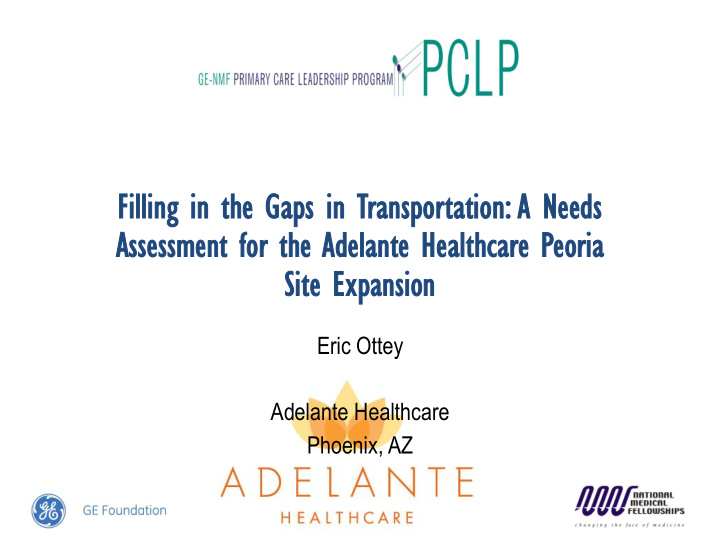



Fil illing ling in in the he Ga Gaps ps in in Transpor nsportation: tation: A Ne A Needs ds As Assessment essment fo for the he Ad Adelante ante He Healthcare lthcare Peoria oria Si Site e Ex Expan pansion sion Eric Ottey Adelante Healthcare Phoenix, AZ
Introduction • Adelante Healthcare is a non-profit organization comprising seven, and soon to be eight, federally qualified health centers. • Patient populations must overcome the social determinants of health that leave them more likely to die early from preventable illness and without adequate care. • Education, employment, and transportation, etc. • I will be assessing the transportation needs of that community by surveying three other Adelante Healthcare clinics in the surrounding area.
Background • Poor transportation inhibits the ability to seek out education options, employment, and healthcare needs. • In environments without a strong public transportation infrastructure health outcomes will be negatively impacted. • Close to 1/3 of the United States population is considered transportation disadvantaged. • The city of Phoenix and its surrounding cities provide public transportation services by contract with private companies. Peoria is not one of them.
Methodology • 5 question survey (see Appendix A) was designed to be short and rapidly administered to a large number of patients. • 3 Adelente Healthcare clinics closest to Peoria were surveyed regarding transportation. • Sites in Surprise, Phoenix, and Avondale. • 124 patients • The surveys were given to patients with the aid of a Spanish translator when necessary.
Sample Patient Survey
Results (Overall) Transportation Usage 2% Public • 69.5% of patients use their personal car, 9% Transportation 19% Personal Car 18.8% get a ride with family or friends, 8.6% Ride from Other take some form of public transportation, 70% 2.3% take taxis Walking • Reliable transportation to their medical visit 10.5% indicated, “No” • Taxi service if a reliable and convenient one Reliability of was available 75% said, “Yes” Transportation NO 10% • Transportation as the main reason for YES missing appointments 10% indicated “Yes” 90%
Results (Overall) • Reliability • personal vehicle 97% felt that it was reliable, 83% from those getting transportation from friends and family, 66% from those taking taxis, and 50% from those using public transportation Reliability of Transportation 100% 80% Believe Reliable 60% 40% 20% 0% Personal Car Public Ride from Other Taxi Transportation
Results (Surprise) 3% Transportation Usage (Surprise) 20% • 25% of total survey results Public Transportation Personal Car • 77% used personal cars, 20% got a ride 77% Ride from Other with family or friends, and only 3% used public transportation • Reliable transportation 97% said “Yes” • Transportation was the main reason for Reliability of Transportation missing any appointments 97% said “No” 3% (Surprise) No Yes 97%
Discussion • A majority of patients use personal transportation or the personal transportation of others to attend appointments at the Adelante Healthcare sites. • Local taxi services are a resource for certain AHCCCS plans but have had mixed reviews overall. • Although the majority of patients that come in have reliable personal transportation, there is area for improvement for the patients using public transportation. • In comparing the Surprise site to Avondale and Phoenix it shows that there is a larger percentage of patients that use public transportation to reach their appointments. These results support the idea that their may be a group of patients that rely on public transportation and are currently unable get to Surprise
Limitations • Inability to survey the no-show patients • Sample size overall. The assessment reached 124 patients • Summer months is not ideal. With increased temperature in the summer, sometimes reaching over 115 o
Recommendations • Begin to incorporate new ways to insure that transportation needs are met by patients. • Suggest adding transportation evaluations into the evaluations currently conducted for the quality assurance already performed. • Suggest incorporating procedures regarding the accessing of taxi services for patients into the orientation for all medical assistants. • Create a shuttle service could be created to shuttle patients from the nearest bus stop, four miles away, to the health center.
Conclusion • Transportation options are a part of the social aspects of health that affect long-term outcomes of patients. • With well-informed providers patients can be more educated regarding their ability to utilize taxi services. • Providing resources to advocate for increased bus routes may create more Valley Metro routes in the future. • Although there were limitations to this study, some insight were observed and future studies will be better equipped to seek out solutions to transportation obstacles.
Acknowledgements • Adelante Healthcare • Audrey Bohanan, Connie Jun, Avein Saaty-Tafoya, MD • Phoenix, Avondale, & Surprise sites • Dr. Jonathan Cartsonis, MD • Prisca Osuji
Recommend
More recommend